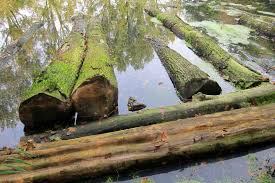 Watering here means laying in the water of fresh cut wood, usually nine months to three to five years. This causes the minerals present, nutrients and starch in the wood are dissolved and rinsed, and it would be much less attractive to insects and bacteria. The increased durability is mainly because watered wood gets less cracks in drying.
Watering here means laying in the water of fresh cut wood, usually nine months to three to five years. This causes the minerals present, nutrients and starch in the wood are dissolved and rinsed, and it would be much less attractive to insects and bacteria. The increased durability is mainly because watered wood gets less cracks in drying.
Prolonged watering the timber becomes unstressed, so beams and planks stay straight.
Hard woods are watered longer. Apples and pears are better and more useful, but should be at least 2 years under water. Oak needs 5 to 10 years.
Watering takes place in pure water, with the bark. The bottom of the trunk is against the current.
Watered wood is easy to bark and cuts better.
Considering wood is expensive, the practice amounts to throwing money into the water. It pays not and so fell into disuse.
There are two techniques for preserving resinous wood by removing all sugars a year before the tree is cut down. One or both can be applied to growing coniferous trees.
The first is the "Ringbarking in Norwegian" technique. When ringing, 25 cm of bark is removed at the bottom of the tree, about 30-50 cm from ground level. Like all vascular plants, trees use two vascular tissues for the transport of water and nutrients: the Xylem (wood) and the phloem (the inner layer of the bark). The rings remove these two vascular tissues and can permanently stop further transport of sugars and water. This will cause the tree to die slowly, removing all sugars and drying the tree before it is felled. The result is a ready-to-use strain that is more stable, less creaky and shrinks, and lasts for many centuries.
The other technique is the "Blæking in Norwegian" (injury) technique. The bark is chopped off randomly in many places so that the tree tries to heal itself and squeezes all the sugars out of the sapwood and replaces it with resin and disinfectants. This makes wood logs (for thousands of years in the whole of Northern Europe) stronger and more resilient. The wood is sometimes called "Amberwood".
It takes a whole cycle of 4 seasons before the tree can be cut after injuring or ringing.
He will begin to die at the end of the next summer (if you injure him in the winter) and will be ready by next winter. According to the old carpenters' calendar, he must be felled when the roots are frozen and when the new moon is approaching.
